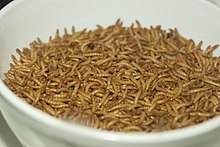Anachronist (
talk |
contribs)
m
Reverted edits by
Carrotnosehead (
talk) to last version by Hadlock |
Tag: repeating characters |
||
| Line 49: | Line 49: | ||
Mealworms may be easily raised on fresh oats, whole wheat bran or grain, with sliced potato or carrots and little pieces of apple as a water source. |
Mealworms may be easily raised on fresh oats, whole wheat bran or grain, with sliced potato or carrots and little pieces of apple as a water source. |
||
The mealworms looks ugly!!!!!!!!!!!!!!!!!!!!!!!!!!!!!!!!!!!!!!!!!!!!!!!!!!!!!!!!!!!!!!!!!!!!!!!!!!!!!!!!!!!!!!!!!!!!!!!!!!!!!!!!!! |
|||
Mealworms have been incorporated into [[tequila]] flavored novelty candies. However, mealworms are not traditionally served in tequila or [[mezcal]] drinks, the latter sometimes containing a larval [[lepidopteran|moth]] (''[[Hypopta agavis]]''). |
|||
==Rearing Mealworms Into Adult Beetles== |
==Rearing Mealworms Into Adult Beetles== |
||
Revision as of 23:36, 16 February 2010
| Mealworm Beetle | |
|---|---|

| |
| Scientific classification | |
| Kingdom: | |
| Phylum: | |
| Class: | |
| Order: | |
| Family: | |
| Genus: | |
| Species: | T. molitor
|
| Binomial name | |
| Tenebrio molitor
Linnaeus, 1758
| |
Mealworms are the larva form of the mealworm beetle, Tenebrio molitor, a species of darkling beetle. Like all holometabolic insects, they go through four life-stages: egg, larva, pupa, and adult. Larvae typically measure about 2.5 cm or more, whereas adults are generally between 1.25 and 1.8 cm in length.
Uses

Mealworms are typically used as a food source for reptile, fish, and avian pets. They are also provided to wild birds in bird feeders, particularly during the nesting season when birds are raising their young and appreciate a ready food supply. Mealworms are high in protein, which makes them especially useful as a food source. They are also commonly used for fishing bait.
They can be purchased at most pet stores and bait shops. They are also available via mail order and via internet suppliers (by the thousand). Mealworms are typically sold in a container with bran or oatmeal for food.
When rearing mealworms, commercial growers incorporate a juvenile hormone into the feeding process to keep the mealworm in the larval stage and achieve an abnormal length of 2 cm or greater.
Tenebrio molitor is also used for biological research. It's relatively large size, ease of rearing and handling, and status as a non- model organism make it an attractive organism for proof-of-principle study. Researchers worldwide, but particularly in Sheffield (UK) and Pusan (Korea), currently use this beetle as a model system for studies in biochemistry, evolution, immunology and physiology.
Reproduction

Mealworm beetles (darkling beetles) are prolific breeders. Mating is a three step process: 1) The male gives chase until the female relents. 2) The male then mounts the female and curls his genitals (aedeagus) underneath himself and inserts it into her genital tract. 3) The male then injects a packet of semen into the female. Dependent on incubation temperature, just days after mating the female will burrow into soft ground and lays about 500 eggs.
Gestation
After 1 week the eggs hatch and larvae emerge. They make excellent food for reptiles.
Larva stage
During the larva stage, mealworms will undergo repeated molting between bouts of eating various vegetation or dead insects. This takes place 10–14 times ( instars) as it gets too big for its current exoskeleton. During its last molt, it loses its carapace before curling into its pupal form.
Pupa stage
The mealworm remains in its pupal stage from 3 days to around 30 days (dependent on incubation temperature and overwintering). The pupa starts off a creamy white color and changes slowly to brown during its pupation stage.

Life history parameter Typical Value Range References Time spent as surviving egg 10 days 10 to 12 days Hill (2002) Time spent as surviving larva 150 days 120 to 540 days Time spent as surviving pupa 20 days not available Hill (2002) Time spent as surviving adult 80 days 60 to 90 days Hill (2002) 6 3 to 20 Number of eggs per surviving adult 80 0 to 500 Dick (1937), Hill (2002) Greenberg and Ar (1996), Hill (2002) Number of larval instars Greenberg and Ar (1996), Hill (2002)
Human consumption

Mealworms may be easily raised on fresh oats, whole wheat bran or grain, with sliced potato or carrots and little pieces of apple as a water source.
The mealworms looks ugly!!!!!!!!!!!!!!!!!!!!!!!!!!!!!!!!!!!!!!!!!!!!!!!!!!!!!!!!!!!!!!!!!!!!!!!!!!!!!!!!!!!!!!!!!!!!!!!!!!!!!!!!!!
Rearing Mealworms Into Adult Beetles
Mealworms are commonly used as feed for reptiles, fish, and birds, and are easily obtained from supply companies. They can be grown in a box eight to ten inches deep. They grow best in well-ventilated containers with large surface areas, and smooth sides to prevent them from escaping. The mealworms are mostly nocturnal and prefer a dark environment. The food for the larvae can be flour or cereals. Moisture is provided by small amounts of fruit or vegetable matter that should be replaced before it goes moldy.
Adult beetles that arise from the larval population are moved to another container prepared with the same food mixture, to lay eggs for more young worms, which are transferred into the first tray. The purpose of using two trays is to provide a continuous supply of worms. Mealworms are also used to keep small insects out of gardens.
External links
- Mealworm information from the Center for Insect Science Education Outreach at the University of Arizona
- Darkling Beetles
- OPH Good Housekeeping - Pest Control
- Edible Insects